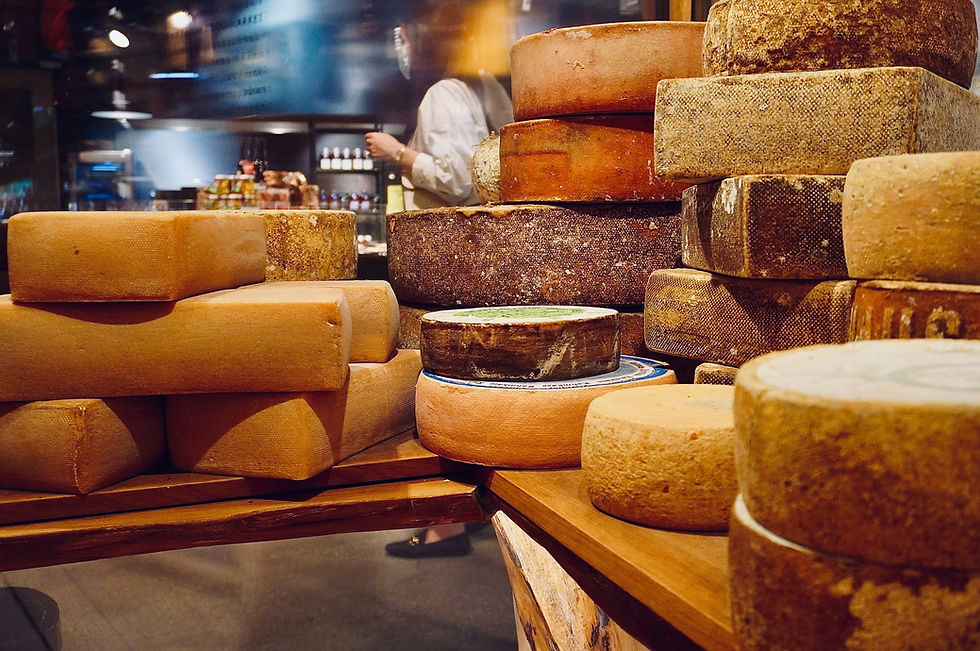From Accidental Discovery to Culinary Delight: The Fascinating Origins of Cheese
- Connor Banks

- Jul 15, 2024
- 3 min read
Cheese is a staple in cuisines around the world, revered for its diverse flavours, textures, and culinary versatility. This beloved dairy product boasts a history as rich and varied as the myriad types we enjoy today. From its accidental discovery to its place in modern gastronomy, the journey of cheese is a tale of human ingenuity, cultural evolution, and culinary artistry.

Accidental Beginnings in the Neolithic Era
The origins of cheese began in the Neolithic era, around 10,000 years ago, shortly after the domestication of sheep and goats. Early humans, storing milk in animal stomachs, inadvertently discovered that it curdled and separated into curds and whey. This serendipitous event laid the foundation for cheese-making, transforming perishable milk into a more durable and portable food source.
Archaeological evidence from around 5500 BCE, found in the region of modern-day Poland, includes pottery with milk-fat residues, indicating early cheese production. These primitive cheese-makers had tapped into a process that would evolve and spread across civilisations.
Ancient Civilisations and the Spread of Cheese
Cheese-making was well established in ancient Mesopotamia and Egypt by 3000 BCE. In Egypt, tomb murals from around 2000 BCE depict the cheese-making process, including straining and pressing curds. These early cheeses were simple and utilitarian, providing a vital source of nutrition.
The Greeks and Romans further refined cheese-making techniques. Greek literature, such as Homer's "The Odyssey," mentions cheese, reflecting its importance in ancient diets. The Romans, known for their culinary innovations, spread their cheese-making knowledge throughout their empire, laying the groundwork for many modern European cheeses.
Medieval Monasteries: The Cradle of Cheese Innovation

During the Middle Ages, European monasteries became centres of cheese production and innovation. Monks in regions like France, Switzerland, and Italy developed classic cheeses such as Roquefort, Brie, and Parmesan. These monastic communities experimented with ageing, flavouring, and preservation methods, contributing to the rich diversity of cheese we know today.
Regional specialities flourished, influenced by local climates, flora, and fauna. For instance, Swiss Emmental cheese, known for its distinctive holes, and England's Cheddar became iconic regional products.
The Renaissance to Industrial Revolution: Refinement and Expansion
The Renaissance period brought further refinement in cheese-making techniques, while the Age of Exploration introduced cheese to the New World. European settlers carried their cheese-making traditions across the Atlantic, planting the seeds for American cheese production.
The 19th-century Industrial Revolution transformed cheese-making. The first cheese factory opened in Switzerland in 1815, followed by the first American cheese factory in 1851, established by Jesse Williams in New York. Mass production techniques standardised cheese quality and made it widely accessible.
Scientific Advancements and Modern Cheese-Making
Advances in microbiology by scientists like Louis Pasteur revolutionised cheese production. Pasteurisation improved safety and consistency, while the development of commercial rennet and controlled bacterial cultures enhanced flavour and texture. These innovations paved the way for the vast array of cheeses available today.
Cheese Today: A Global Culinary Treasure

In the 20th century, cheese-making spread globally, with countries developing their unique varieties. Despite the rise of industrial production, there has been a resurgence of interest in artisanal and farmstead cheeses. Cheese enthusiasts now seek out traditional methods and unique flavours, supporting sustainable practices and local economies.
Regions renowned for their cheese heritage, such as France and Italy, continue to protect and celebrate their cheese-making traditions. The cultural significance of cheese is reflected in its prominent role in cuisines worldwide, from simple snacks to gourmet dishes.
A Culinary Journey Through Time
From its humble beginnings as a happy accident to its status as a culinary delight, cheese has evolved into a complex and cherished food. Each variety tells a story of the region and the people who created it, making cheese not just a food, but a cultural artifact. As we enjoy a slice of Gouda or a wedge of Stilton, we partake in a rich history that spans millennia, connecting us to the ancient past and the innovative present.
Cheese, in its myriad forms, continues to captivate and delight, a testament to the enduring human spirit of innovation and creativity. So, the next time you savour your favourite cheese, remember the incredible journey it has taken to reach your plate—a journey that continues to evolve with each delicious bite.






